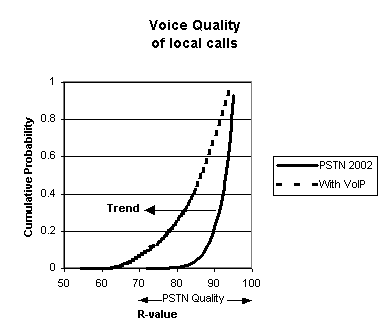4. TRADITIONAL TRANSMISSION PLANNING AND VOIP
Traditional transmission planning has been based on establishing nominal (preferred) and limiting values for loudness and other parameters. Budgets for end-to-end connections are allocated for each component; the CPE, the access lines, and the core network as far as the point of interconnection to other national networks and the international network. Similar design practices are used by other networks and countries in line with the ITU-T Recommendations for end-to-end call quality.
This approach has resulted in most connections having near optimal voice quality with only a very small proportion of connections experiencing worst case conditions. The probability of telephones and access lines at both ends of any given connection all having worst case transmission conditions at the same time is relatively low.
R-value is a quality rating as determined using the ITU-T Rec.G.107 E-model. For an all digital network the maximum possible R-value is 93.2. An R-value of 70 indicates some users would be dissatisfied and an R-value of 50 that nearly all users would be dissatisfied.
This is illustrated by the curve on the right-hand side of the figure below, which indicates the quality of circuit-switched PSTN local calls, with very few calls having an "R-score" of less than 80..
It is expected that growing use of VoIP in both private and public networks will mean that more and more calls traversing the PSTN will experience at least some additional impairments. If there is too much cost-cutting and these networks are not properly designed to maintain good voice quality, the trend will be for higher percentages of calls to experience poorer transmission, leading to increased user dissatisfaction. This trend is illustrated by the left-hand curve of the figure.

WARNING:
Telecom acknowledges and supports the move to VoIP, but if too many VoIP private network implementations elect to trade voice quality for lower cost then the end result may be far worse than indicated above, with a lot more calls falling into the "below 70" class.
Should this occur, EVERYONE will be affected to at least some extent. However, poor service quality will be far more apparent to those customers connected to a "cut cost" private network, as they will have higher probability of connecting to another similar network than will the average caller.

5. WHAT HAS TO BE DONE?
Newsletter No. 135 and subsequent Newsletters will provide a lot more detail on private network design matters. Unfortunately, many of the various design parameters and impairments are interactive and it is no longer a simple case of setting limits on the impairments or characteristics of each network or CPE item in isolation.
This is where there is a collective responsibility for not only public network operators, but also for each private network operator to ensure that a more moderate approach is taken to cost cutting.
DOUG BURRUS
Manager
Access Standards


